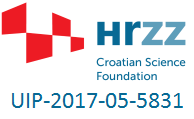New publication
10/03/2023In collaboration with the scientists from Institute Ruđer Bošković we published a paper about photogeneration of carbenes in anti-Kasha reactions from upper excited states of diazoalkanes.
Ultrafast photoelimination of nitrogen from upper excited states of diazoalkanes and the fate of carbenes formed in the reaction
Vedran Brusar, Mateo Forjan, Ivan Ljubić, Marija Alešković, Kristin Becker, Silvije Vdović
Photochemical reactivity of diphenyldiazomethane 1, and phenyl 1- and 2-adamantyl diazomethanes 2 and 3 was investigated experimentally by transient absorption spectroscopy (TA) with the time resolution from femtoseconds to milliseconds. We have gathered spectroscopic evidence that the photoelimination of N2 upon excitation at 267 nm takes place in the anti-Kasha ultrafast photochemical reaction within 1 ps directly from the upper excited singlet states. The N2 elimination delivers singlet carbenes, that were in the case of 1 and 2 detected by fs-TA. The reactivity of carbenes differs with respect to the substituent at the carbene center. The singlet car-1 in nonpolar solvent predominantly delivers the triplet carbene by ISC. On the contrary, ISC for car-2 giving the corresponding triplet carbene was not detected. Instead, the singlet car-2 has longer lifetimes and reacts in the intermolecular insertion reactions into C-H bonds. Car-3 has an α C-H bond next to the carbene center, and therefore, reacts rapidly in the intramolecular C-H insertion reaction delivering alkene photoproduct, precluding its detection by fs-TA. However, isolation of ketone photoproducts from 3 is highly indicative of the formation of the triplet car-3 as a reactive intermediate. The TA spectra from the S1, S2, and S3 excited states of 1, 2, and 3 were computed using time-dependent density functional theory (TD-CAM-B3LYP) while the multiconfigurational perturbation theory to the second order (CASPT2) was used for the absorption spectra of the corresponding singlet and triplet carbenes. The modeled and measured TA spectra are in good agreement, and the computations corroborate the assignments of the key short-lived intermediates in the photoinduced reactions of 1, 2, and 3.

 Group for Applied Ultrafast Spectroscopy
Group for Applied Ultrafast Spectroscopy